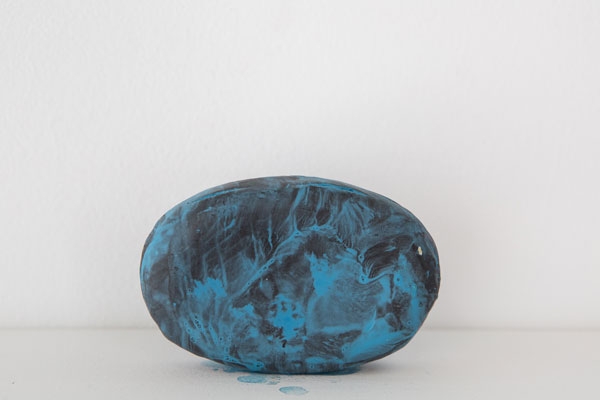Accompanying this show is a short written dialogue adapted by Kate Owens from a 1954 children’s story by Maria Bird – Andy Pandy’s Tea Party, if I’m not mistaken. Two children, ‘AP’ and ‘T’, are invited to paint the walls and furniture of a ‘plain room’. After experimenting with ‘stripes’, ‘paw marks’ and ‘splodges’, they are ‘covered head to foot in all the colours of the rainbow’. Finally, unable to distinguish their own bespattered bodies from their surroundings, ‘they [fetch] pails and soap and scrubbing brushes and [wash] everything – even the walls.’
This isn’t just a literary framing device, but a fictionalised account of a workshop activity undertaken with four children prior to the show. Five works (all 2013) stand as a record of that event: The Trees Get New Leaves in Spring, a partially erased mural on the end wall of Limoncello; Towards Zero (1–18), 18 bars of soap arrayed on two long shelves; Hollows (White), a Perspex box filled with disposable shoe covers; and Hollow (Blue), a Perspex box containing a single pair of shoe covers. Thus, the janitorial supplies used to erase the mural are recouped as part of the installation. In the fifth work, The Trees Get New Leaves in Spring (Tables and Chairs), the table and chairs from the workshop have been placed in the foyer, still covered in paint.
Where Owens’s written dialogue captures the social richness of the workshop (‘What shall we stand on?’ ‘Let’s cover the walls in bright colours’), this quintet of works neutralises it. The soaps are beautiful, like miniature abstract paintings, swirled and caked with pigment and child-sweat, but their inclusion alongside the vitrined shoe covers and erased mural locates them within a discourse of dematerialisation, the endgame aesthetics of conceptual art. Presenting the physical remnants of a real event alongside its fictionalised retelling is a good idea, but the format of that retelling – a flimsy photocopied document next to the comments book – surely downplays its significance. I watched several viewers ignore it.
Also included are some block prints that, according to the artist, were ‘created using the first known method of wallpaper printing’. Owens had access to the archive of the Anstey Wallpaper Company in Loughborough, where she replicated four of William Morris and Arthur Sanderson’s blocks, minus the patterns, replacing them with square monochromes and retaining only the registration marks, rendered as peripheral dots of colour. The original designs must be inferred from the titles: From the Department of Dead Ends (Trellis), From the Department of Dead Ends (Willow).
Owens adopts a refreshingly perverse approach to social participation here, involving people only to eradicate their contributions. But the outcomes feel perfunctory, too reminiscent of the historical avant-garde – with its stock menu of iconoclasms: art as erasure and effacement, the nullification of subject matter – to surprise us. True, with The Trees Get New Leaves in Spring, there is a misanthropic thrill that comes from knowing the kids had to ‘clean up’ their own picture in order to facilitate Owens’s deconstruction of the artistic gesture, but the results still seem inevitable, less a product of this sociality than an excuse for it.
This article was first published in the December 2013 issue.
